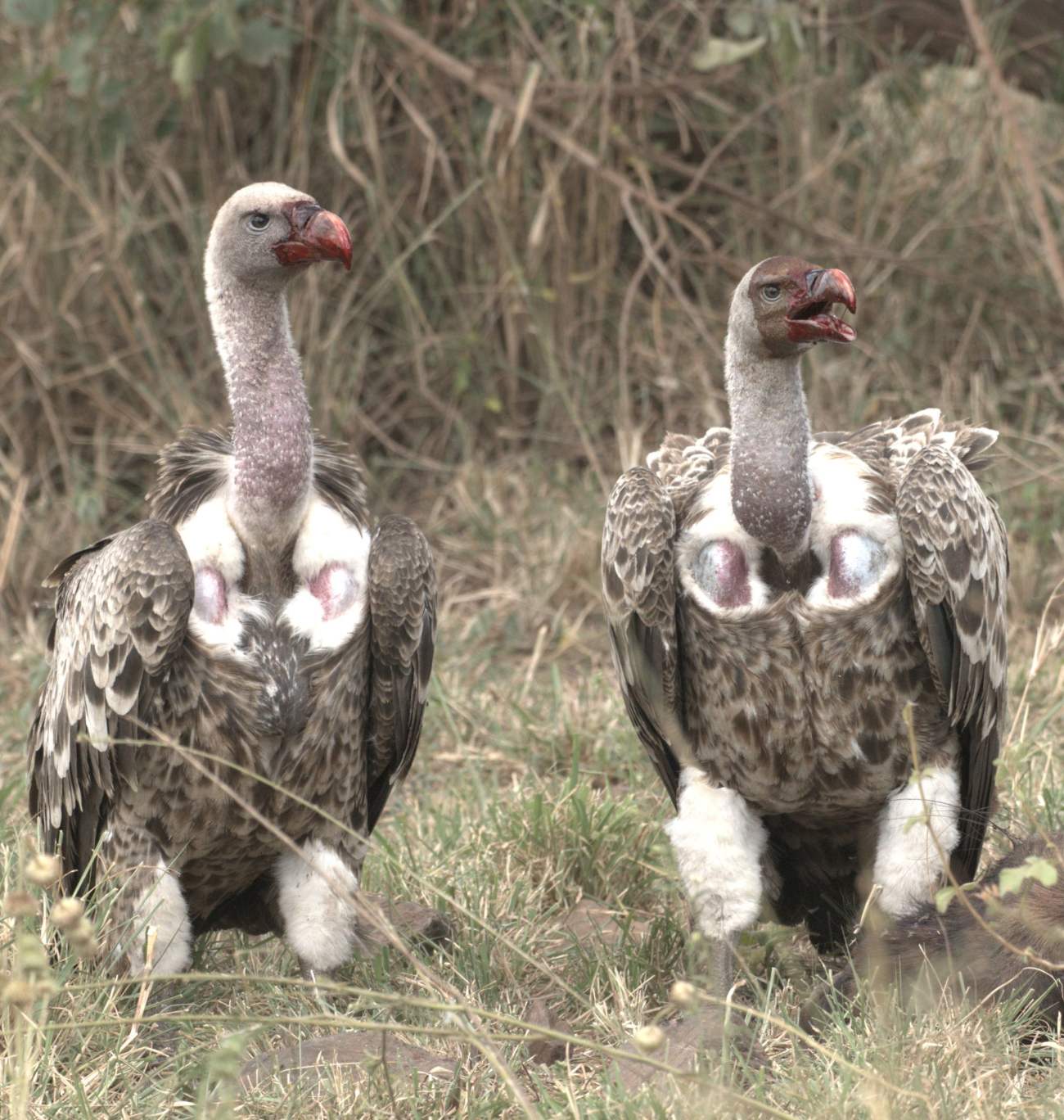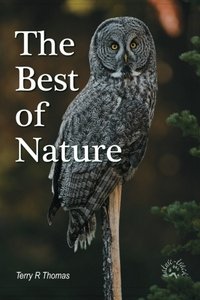Vultures

Beaks stained with blood, these two Ruppell’s griffons have been dining on a wildebeest, recently killed by lions.
Serengeti National Park, Tanzania, Africa.
The large animal had not been dead 24 hours but it was already unrecognizable except for its wildebeest horns. Lions and hyenas has already had their way with the remains and now that the hard work of opening the carcass had been completed, the cleaning crew had moved in. At least three species of vultures, Ruppell’s griffon and white-backed and lappet-faced vultures, were on the ground and dropping in from the nearby tree while others circled high in the sky. Squabbles, punctuated with hisses, outstretched wings, and snapping beaks, kept the dozen excited birds on alert and there seemed to be more posturing than eating going on. When tempers diminished and a hierarchy was established, feeding commenced in earnest.
Vultures are birds of prey, members of the same order as eagles, hawks, and falcons. Worldwide, there are 23 living species including the condors, 16 in the Old World and 7 in the New World (including our three North American species, turkey and black vultures and the California condor). They have strong hooked beaks and most have bald or nearly bald heads. They have weak talons though, compared to other raptors, and are obligate scavengers, rarely if ever killing healthy animals. And, they do not carry pieces of meat back to their nestlings, rather they disgorge food already swallowed.
Although the New and Old world vultures look and function similarly, they are not that closely related. The Old World vultures are members of the Accipitridae family which includes the eagles, hawks, kites, and buzzards. The New World vultures are members of the Cathartidae family. Similarities between the two are thought to have developed through a process known to scientists as convergent evolution.
Most vultures locate their meals visually and all have keen vision. However, the turkey vulture is thought to have a highly developed sense of smell to locate food from miles away. Recently, research has shown that hearing also plays a part in locating feeding sites. When researchers played over loudspeakers the sound of a wildebeest calf distress call or of lions and hyenas squabbling at a kill, vultures and other birds responded to the sounds even though there was no actual meal available.
Vultures are well adapted to scavenging the dead. Besides the bald head which keeps the birds cleaner when diving into delicious carrion and broad wings that let them soar and look for a meal for hours, they have battery acid for digestive juice—almost literally. A vulture’s stomach has a pH of 0.87-1.0 and car battery acid has a pH of 0.8. Human stomach acid has a pH of 2.0 which doesn’t sound like much of a difference. However, the pH scale is logarithmic not linear, so a one point change is a 10X increase or decrease in potency. What that means is that most wildly toxic organisms such as botulinum toxin, hog cholera virus, and anthrax bacteria cannot survive in the vulture’s stomach. Vultures can scavenge with impunity dead things that would kill other scavengers. Vultures also have an incredibly strong immune system to attack any organism that escapes the acid bath.
Like many families with multiple species, vultures have some specialists in their group. One is the Lammergeiers, also called the bearded vulture. This bird inhabits mountainous regions of Africa, Europe and Asia and specializes in eating bones. Well, not exactly bones, but bone marrow. It carries bones in its talons high in the air and then drops them onto rocks to break them open to access the marrow.
The Egyptian vulture is a small Old World bird known for its use of tools. While mainly a carrion feeder, it also feeds on eggs of large birds such as ostriches. To break open a thick-shelled egg (0.20 inches thick for an ostrich), it uses a rock that it drops on the egg, making it one of the very few birds to use tools. In the tool use category, it also uses a stick to roll up wool to use as nesting material.
This article would not be complete without a bit of vulture trivia. So, did you know that vultures circling in the sky are called a “kettle” while vultures on the ground are called a “committee”?
Because vultures feed on carrion, they have a less-than-respectful place in the mind of most humans. We may call some unsavory character a “vulture” or say that the “vultures are circling” when we see someone trying to take unfair advantage of another. However, without vultures and other scavengers, we would quickly be overrun by piles of dead animals and the diseases that they would produce.
So, as the saying goes, it’s a dirty job, but someone has to do it. We should be thankful for vultures and the deadly mess that they save us from.

Help Idaho Wildlife
When we traveled across the state in October 2017, we visited most of the Idaho Department of Fish and Game wildlife management areas. Most of the vehicles we saw using the wildlife management areas did not have wildlife plates. Buying wildlife plates is a great way for non-hunters and hunters alike to support wildlife-based recreation like birding.
C'mon folks, let's help Idaho's wildlife by proudly buying and displaying a wildlife license plate on each of our vehicles!
See below for information on Idaho plates. Most states have wildlife plates so if you live outside Idaho, check with your state's wildlife department or vehicle licensing division for availability of state wildlife plates where you live.
And tell them that you heard about it from Nature-track.com!
Wildlife License Plates
Great news! as of 2024, there are three NEW designs for license plates. They still are bluebird, cutthroat trout and elk, but they are beautiful.
Idaho Wildlife license plates provide essential funding that benefits the great diversity of native plants and wildlife that are not hunted, fished or trapped—over 10,000 species or 98% of Idaho’s species diversity. Game species that share the same habitats (such as elk, deer, antelope, sage-grouse, salmon, trout) also benefit from these specialty plates.
No state tax dollars are provided for wildlife diversity, conservation education and recreation programs. Neither are any revenues from the sale of hunting or fishing licenses spent on nongame species. Instead, these species depend on direct donations, federal grants, fundraising initiatives—and the Idaho Wildlife license plates.
Both my vehicles have Bluebird Plates. I prefer the bluebird because the nongame program gets 70 percent of the money from bluebird plates, but only 60 percent of the money from elk and trout plates - 10 percent of the money from elk plates supports wildlife disease monitoring and testing programs (to benefit the livestock industry) and 10 percent from cutthroat plates supports non-motorized boat access.
Incidentally, in 2014, the Idaho Legislature denied the Department of Fish and Game the ability to add new plates or even to change the name of the elk and cutthroat plates (very specific) to wildlife and fish plates, a move that would have allowed for changing images occasionally and generating more revenue. It would seem that they believe that we Idahoans don't want a well funded wildlife program.
I think it is time we let the Legislature know that Idahoan support wildlife funding and that we would like to see these generic plates come to fruition.

"WOW. What a phenomenal piece you wrote. You are amazing." Jennifer Jackson
That is embarrassing, but actually a fairly typical response to my nature essays. Since The Best of Nature is created from the very best of 16 years of these nature essays published weekly in the Idaho Falls Post Register (online readership 70,000), it is a fine read. It covers a wide variety of topics including humorous glimpses of nature, philosophy, natural history, and conservation. Readers praise the style, breadth of subject matter and my ability to communicate complex and emotional topics in a relaxed and understandable manner.
Everyone can find something to love in this book. From teenagers to octogenarians, from the coffee shop to the school room, these nature essays are widely read and enjoyed.
Some of the essays here are my personal favorites, others seemed to strike a chord with readers. Most have an important message or lesson that will resonate with you. They are written with a goal to simultaneously entertain and educate about the wonderful workings of nature. Some will make you laugh out loud and others will bring a tear to the eye and warm your heart.
Readers Write:
"You hit a home run with your article on, Big Questions in Nature. It should be required reading for everyone who has lost touch with nature...great job!" Joe Chapman
"We enjoyed your column, Bloom Where Planted. Some of the best writing yet. The Post Register is fortunate to have your weekly columns." Lou Griffin.
To read more and to order a copy, click here or get the Kindle version
Copies are also available at:
Post Register
Island Park Builders Supply (upstairs)
Barnes and Noble in Idaho Falls
Harriman State Park, Island Park
Museum of Idaho
Valley Books, Jackson Wyoming
Avocet Corner Bookstore, Bear River National Wildlife Refuge, Brigham City, Utah
Craters of the Moon National Monument Bookstore, Arco, Idaho